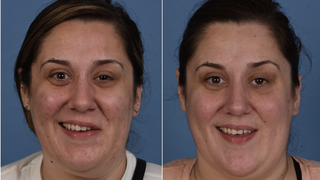What Causes Facial Paralysis?
It occurs when cranial nerve number 7, also known as the facial nerve, is injured. The facial nerve is responsible for stimulating:
- The muscle responsible for motions in the face
- The gland responsible for producing tears
- The small muscle in the ear responsible for dampening certain noises
- The taste gland in the tongue
- Sensation in a small portion of the skin of the ear
Injury to the facial nerve may affect several aspects of the face, depending on the degree and location of facial nerve injury.
The common causes of facial paralysis include the following:
Bell's Palsy
Bell's palsy is the most common form of facial paralysis in the United States, with approximately 15,000 to 40,000 cases a year. Named after a 19th-century Scottish surgeon, the condition is actually a diagnosis of exclusion – meaning the true reason for the facial palsy is unknown.
The most common symptom of Bell's palsy is a sudden onset of paralysis on one side of the face, which is often associated with ear pain. It has been reported to occur more frequently with some other conditions, namely pregnancy and diabetes.
During pregnancy, facial paralysis tends to occur most commonly in the third trimester and usually resolves itself after delivery. In other cases, facial paralysis may occur in the immediate postpartum period.
Most patients fully recover from Bell's palsy. A primary care physician, neurologist, or otolaryngologist usually diagnoses and treats the condition.
Congenital (at Birth) Facial Palsy
Babies may be born with facial paralysis and often the cause is unclear. In the past when delivery was performed with forceps, sometimes facial nerve injuries could occur. Congenital facial palsy may appear also as part of a syndrome and involve one or both sides of the face.
Moebius Syndrome
Moebius Syndrome is a rare form of bilateral facial paralysis in which the sixth cranial nerve (abducens nerve) responsible for lateral motion of the eye is also involved. Moebius Syndrome has varying symptoms and may be difficult to diagnose at birth.
Often, additional cranial nerves are involved and sometimes extremities may have abnormalities, chest muscles may be involved, and eyelids, ear, and lip deformities may be seen. Still, many patients are healthy. The cause of this syndrome is not clearly known.
Surgery or Medical Procedures
Facial paralysis may be caused inadvertently by medical intervention or may at times be an inseparable part of a procedure in which the facial nerve must be removed. This includes:
- Cosmetic procedures, such as facelifts
- Dental procedures
- Mastoid or parotid surgery
- Nerve blocks in the face
- Skull base surgery
Not all facial paralysis after procedures is permanent. Procedures in the area of the nerve will often cause temporary paralysis (neuropraxia) and recovery can be seen over several months.
If the nerve has been transected during surgery, it is necessary to reconstruct the nerve either by direct suturing or by grafting, and in certain cases, other procedures are needed.
Trauma
Trauma that causes facial nerve paralysis generally occurs in one of two locations:
Intracranial Trauma (Trauma Within the Skull)
The facial nerve courses through the temporal bone between where the nerve leaves the brainstem and where it exits the skull and enters the face. Any trauma strong enough to cause a fracture of this temporal bone may cause facial nerve paralysis.
This is often seen after motor vehicle accidents or blast injuries and is more common in adults, although it may occur in children. If the paralysis occurs immediately after the accident, surgery involving decompression of the nerve via the skull base is performed by neurosurgeons and otolaryngologists.
Close monitoring of the condition, rather than active treatment, is chosen when the paralysis progresses slowly.
Extracranial/Facial Trauma
This type of injury is most commonly penetrating, either from a knife cut or projectile. Dental procedures or nerve blocks rarely cause this type of injury.
Recovery can sometimes be seen without surgical intervention if the injury is close to the middle of the face, where the nerve branches are very small but also interconnect with other branches. If the injury is more to the side of the face, surgical repair of the nerve is usually needed, preferably within the first 72 hours of injury.
The decision of whether to repair the nerve and the choice of surgical technique is usually made by an experienced plastic and reconstructive surgeon who has advanced training in facial nerve surgery and microsurgery.
Tumors
Facial nerve paralysis can be caused by tumors. Acoustic neuroma, cholesteatoma, schwannoma, and invasive carcinomas are among the more common tumors.
Symptoms may vary, from an acute paralysis that shows no improvement over several months to a slowly progressive paralysis that’s often accompanied by synkinesis (abnormal twitching or motion in the face).
Early diagnosis is critical, and imaging studies, such as computed tomography (CT) scans and magnetic resonance imaging (MRIs), are usually needed to identify the extent of the tumor. Based on the imaging findings, the treatment plan may involve surgery, radiation, or both.
The removal of tumors itself may cause facial paralysis. However, inadvertent injury to the facial nerve is uncommon in the hands of experienced skull base surgeons, usually otolaryngologists and neurosurgeons.
When a tumor is very close to the facial nerve or even surrounding the facial nerve, temporary or permanent facial paralysis may occur after tumor removal. In some cases, especially if cancerous tumors are involved, the facial nerve may be altered to obtain clear removal of the tumor.
Viruses
Several viruses, including varicella-zoster, herpes simplex, and Epstein-Barr (EBV) may cause facial paralysis.
The varicella-zoster virus causes Ramsay Hunt syndrome, in which patients often have a history of ear pain, peripheral facial paralysis, and a rash located in the ear canal.
Ramsay Hunt syndrome is also characterized by hearing loss, painful sensitivity to noise, and reduced tearing. Full recovery is usually less common than in Bell’s palsy, and more patients end up with complete nerve loss and synkinesis.
Ear infections, infectious mononucleosis, and AIDS may also cause facial paralysis.
Lyme Disease
Another known infectious cause for facial paralysis is Lyme disease, seen more on the East Coast and caused by ticks commonly found on deer. Approximately 11 percent of patients with Lyme disease develop facial paralysis. Paralysis is on both sides of the face in 30 percent of cases.










